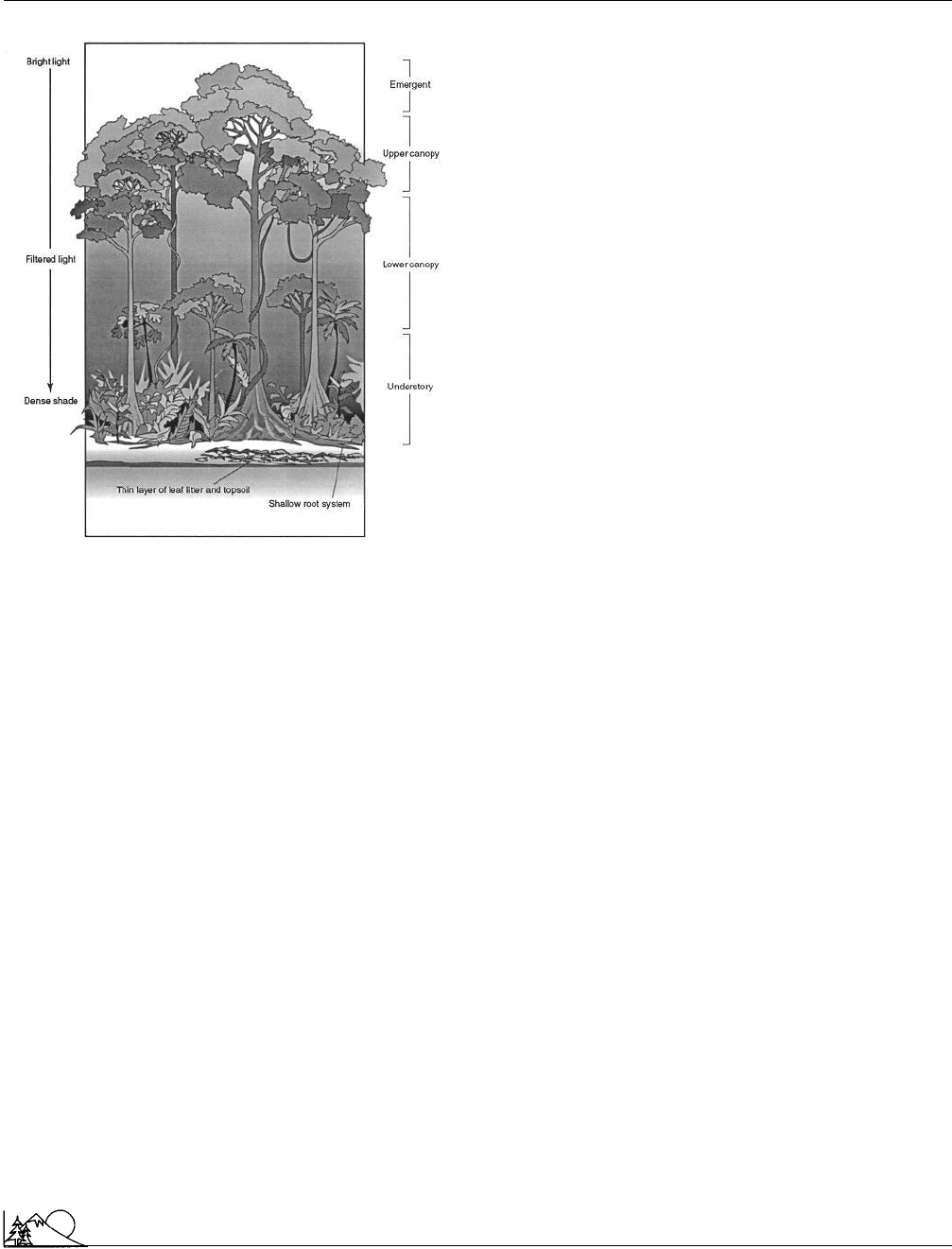Environmental Encyclopedia
Подождите немного. Документ загружается.


Environmental Encyclopedia 3
Trophic level
that countries adopt measures to restrict the use and release
rate of TBT-based antifouling paints. Since that recommen-
dation, many countries have prohibited the use of TBT anti-
fouling paints on small craft. New Zealand and Japan banned
the use of TBT anti-fouling paints on all ships. In 1998,
the IMO agreed to ban the application of TBT-based paints
by 2003 and their presence on ships by 2008. Due to the
ensuing reductions in the use of TBT-based paints, both
TBT contamination and its effects on organisms have been
decreasing worldwide.
Less toxic alternatives to TBT are being developed
quickly. In the animal and plant worlds, researchers have
found over 50 naturally-occurring substances that have the
same effects as TBT and other antifouling paints, keeping
organisms such as algae and some invertebrates from becom-
ing laden with other forms of algae and sea life. In addition,
other alternatives to TBT have been developed, and include
epoxy-copper flake paints, which may protect boats for up
to 10 years, but cannot be used on ships with aluminum
hulls. Ceramic-epoxy coats are also available, and can be
used on fiberglass and metal hulls. Other alternativess to
TBT are foulant-release coatings that contain silicone elasto-
mers that last as long as the copolymers in TBT. Finally,
researchers are studying eletrical current systems that can
sterilize the hulls of ships for up to four years as another
alternative.
[Judith L. Sims]
R
ESOURCES
B
OOKS
de Mora, S. J., ed.Tributyl Tin: Case Study of an Environmental Contami-
nant.Cambridge, UK: Cambridge University Press, 1997.
St. Louis, Richard.Tributyl Tin: The Case for Virtual Elimination in Canada.-
Toronto, Canada: World Wildlife Fund Canada, 1999.
O
THER
“Antifoulants.” Organotin Environmental Programme (ORTEP). Associa-
tion, The Hague, The Netherlands. [cited June 21, 2002]. <http://ortep-
a.org/pages/antifoulants.htm>.
Trihalomethanes
Trihalomethanes (THMs) are organic
chemicals
composed
of three halogen atoms (primarily
chlorine
and
bromine
)
and one
hydrogen
atom bound to a single
carbon
atom.
They are commonly used as solvents in a variety of applica-
tions, and trichloromethane (or chloroform) was once used
by medical doctors as an anesthetic. In 1974, Johannes Rook
of the Netherlands discovered the presence of THMs in
chlorinated drinking water. He and other researchers subse-
quently demonstrated that minute quantities of THMs are
formed during
water treatment
. Chlorine, when added to
1427
disinfect the water, reacts with naturally occurring organic
matter present in the water.
Groundwater
can also be con-
taminated with THMs if people use them improperly, re-
lease them accidentally, or dispose of them unsuitably. Since
high dosages of chloroform had been found to produce
can-
cer
in mice and rats, the United States
Environmental
Protection Agency
(EPA) amended the drinking water
standards in 1979 to limit the concentration of THMs to a
sum total of 100 parts ber billion, or 0.1 mg/l. In 1998, a
more stringent limit of 0.08 mg/l was introduced. See also
Carcinogen; Drinking-water supply; Water quality stan-
dards
Trophic level
One way of analyzing the biological relationships within an
ecosystem
is to describe who eats whom within the system,
also called a functional analysis. Each feeding level in an
ecosystem is called a trophic level. In the
grasslands
, for
example, plants are considered primary producers, forming
the first trophic level. The second trophic level consists of
primary consumers, such as deer, mice, seed and fruit-eating
birds, and other animals, depending completely on the pri-
mary producers for their food. Carnivores and predators,
such as hawks, are the secondary consumers. Often, the same
species
may fit into several categories. Bears, for example,
are considered both primary and secondary consumers be-
cause they feed on plant matter as well as meat. Bacteria
and
fungi
that decompose dead organic matter are called
the
decomposers
. Thus, on the basis of food source and
feeding behavior, a complex
food chain/web
exists within
any ecosystem and every species belongs to one or more of
several trophic levels.
In
environmental science
, the concept of trophic
levels is often used to assess the potential for transfer of
pollutants through an ecosystem. Since each trophic level is
dependent on all the other levels, positive or negative changes
in the composition or abundance of any one trophic level
will ultimately affect all other levels. In ecosystems that
normally have stable, complex trophic levels within the food
web,
pollution
can lead to fluctuations and simplification
of the trophic levels. Contaminants that are taken up by
plants from the
soil
may be transferred to primary and
secondary consumers through their feeding patterns. This
is known as trophic level transfer.
A classic example of trophic level transfer was the
release of DDT in the
environment
. DDT is an insecticide
commonly used in the United States during the 1950s and
early 1960s. DDT ran off treated fields into lakes and rivers,
where it accumulated in the fatty tissues of primary consum-
ers such as fish and shellfish. The
chemicals
were then

Environmental Encyclopedia 3
Tropical rain forest
transferred into secondary consumers, such as eagles, which
fed on the primary consumers. While the concentrations of
DDT were rarely high enough to kill the birds, it did cause
them to lay eggs with thin shells. The thin eggshells led to
decreased hatching success and thus caused a decline in the
eagle population.
Trophic level analysis is a commonly used method
of environmental assessment. A pollutant or disturbance is
assessed in terms of its effects on each trophic level. If
significant amounts of nutrients are brought into a lake
receiving
fertilizer runoff
from fields, a spurt in the growth
of algae (primary producers) in the lake may be triggered.
However the increased growth might actually be dominated
by certain algal groups, such as blue-green algae, which may
not constitute desirable food sources for the
zooplankton
and fish (primary consumers) which normally depend on
algae for food. In this case, even though the environmental
conditions might appear to stimulate increased growth in
one trophic level, the nature of the change does not necessar-
ily prove advantageous to other trophic levels within the
same system. See also Agricultural pollution; Algal bloom;
Aquatic weed control; Balance of nature; Bald eagle; Decom-
position; Environmental stress; Predator control; Predator-
prey interactions
[Usha Vedagiri]
R
ESOURCES
B
OOKS
Connell, D. W., and G. J. Miller. Chemistry and Ecotoxicology of Pollution.
New York: Wiley, 1984.
Smith, R. L. Ecology and Field Biology. New York: Harper and Row, 1980.
Tropical rain forest
The richest and most productive biological communities in
the world are in the tropical forests. These forests have been
reduced to less than half of their former extent by human
activities and now cover only about 7% of Earth’s land area.
In this limited area, however, is about two-thirds of the
vegetation mass and about half of all living
species
in the
world.
The largest, lushest, and most biologically diverse of
the remaining tropical moist forests are in the
Amazon
Basin
of South America, the Congo River basin of central
Africa, and the large islands of southeast Asia (Sumatra,
Borneo, and Papua, New Guinea). Whereas the forests of
mainland southeast Asia, western Africa, and Central
America are strongly seasonal, with wet and dry seasons,
the South American and central African forests are true rain
forests. Rainfall is generally over 160 in (406 cm) per year
and falls at a relatively even rate throughout the year. It is
1428
said that such rainforests “make their own rain,” because
about half the rain that falls in the forests comes from con-
densation of water vapor released by
transpiration
from
the trees themselves. Rain forests at lower elevations are
hot and humid year-round. At higher elevations, tropical
mountains intercept moisture-laden clouds, so the forests
that blanket their slopes are cool, wet, and fog-shrouded.
They are aptly and poetically called “cloud forests.” Tropical
forests are generally very old. Unlike temperate rain forests,
they have not been disturbed by
glaciation
or mountain-
building for hundreds of millions of years. This long period
of
evolution
under conditions of ample moisture and stable
temperatures has created an incredible diversity of organisms
of amazing shapes, colors, sizes, habits, and specialized adap-
tations.
Habitats in a tropical
rain forest
are stratified into
three to five distinct layers from ground level to the tops of
the tallest trees. Hundreds of tree species grow together in
lush profusion, their crowns interlocking to form a dense,
dappled canopy about 120 ft (37 m) above the forest floor.
These unusually tall trees are supported by relatively thin
trunks reinforced by wedge-shaped buttresses that attach to
a thick mat of roots just under the
soil
surface. A few
emergent trees rise above the seemingly solid canopy into a
world of sunlight, wind, and open space. Numerous species
of birds, insects, reptiles, and small mammals live exclusively
in the forest canopy, never descending below the crowns of
the trees.
The forest understory is composed of small trees and
shrubs growing between the trunks of the major trees, as
well as climbing woody vines (lianas) and many epiphytes—
mainly orchids, bromeliads, and arboreal ferns—that attach
themselves to the trees. Some of the larger trees may support
50–100 different species of epiphytes and an even larger
population of animals that are specialized to live in the many
habitats they create. These understory layers are a world of
bright but filtered light abuzz with animal activity.
By contrast, the forest floor is generally dark, humid,
quiet, and rather open. Few herbaceous plants can survive
in the deep shade created by the layered canopy of the forest
trees and their epiphytes. The most numerous animals are
ants and termites that scavenge on the
detritus
raining down
from above. A few rodent species gather fallen fruits and
nuts. Rare predators such as leopards, jaguars, smaller cats,
and large snakes hunt both on the ground and in the un-
derstory.
A tropical rain forest may produce as much as 90 tons
(81.6 metric tons) of
biomass
per acre (0.4 ha) per year,
and one might think that the soil that supports this incredible
growth is rich and fertile. However, the soil is old, acidic,
and nutrient-poor. Ages of incessant tropical rains and high
temperatures have depleted minerals, leaving an iron- and

Environmental Encyclopedia 3
Troposphere
The layered communities of a tropical rain for-
est are directly related to the gradual lessening
of light, from the brightness of the canopy to
the dense shade of the forest floor. (Illustration by
Hans & Cassidy.)
aluminum-rich podzol. Tropical forests have only about 10%
of their organic material and nutrients in the soil, compared
to boreal forests, which may have 90% of their organic mate-
rial in litter and sediments.
The interactions of
decomposers
and living plant
roots in the soil are, literally, the critical base that maintains
the rain forest
ecosystem
. Tropical rain forests are able to
maintain high productivity only through rapid
recycling
of
nutrients. The constant rain of detritus and litter that falls
to the ground is quickly decomposed by populations of
fungi
and bacteria that flourish in the warm, moist
environment
.
Some of these decomposers have symbiotic relationships
with the roots of specific trees. Trees have broad, shallow
root systems to capitalize on this surface
nutrient
source;
an individual tree might create a dense mat of superficial
roots 328 ft (100 m) in diameter and 3 ft (0.9 m) thick. In
this way, nutrients are absorbed quickly and almost entirely
and are reused almost immediately to build fresh plant
growth, the necessary base to the trophic pyramid of this
incredible ecosystem. See also Biodiversity
[William P. Cunningham Ph.D.]
1429
R
ESOURCES
B
OOKS
Caufield, C. In the Rainforest. New York: Knopf, 1985.
Hecht, S., and A. Cockburn. Fate of the Forest. New York: Harper Col-
lins, 1991.
Myers, N. The Primary Source: Tropical Forests and Our Future. New York:
Norton, 1992.
Revkin, A. The Burning Season: The Murder of Chico Mendes and the Fight
for the Amazon Rain Forest. New York: Houghton Mifflin, 1991.
P
ERIODICALS
Repetto, R. “Deforestation in the Tropics.” Scientific American 262 (April
1990): 36–42.
Tropopause
The tropopause is the upper boundary of the
troposphere
,
a layer of the earth’s
atmosphere
near the ground. In the
troposphere, the temperature generally decreases with in-
creasing altitude, with restricted exceptions called inversions.
However, at a height of about 6 mi (10 km) at the poles 9
mi (15 km) at the equator, the temperature abruptly becomes
constant with increasing altitude. This isothermal region is
called the
stratosphere
, and the interface between it and
the troposphere is called the tropopause. Mixing of air across
the tropopause is slow, occurring on a time scale of weeks
on the average, while tropospheric mixing is more rapid.
The existence of the stratosphere is largely caused by
the
absorption
of
solar energy
, mostly ultraviolet light,
by oxygen to form
ozone
. The balance of the heating is
caused by absorption of other parts of the solar spectrum by
other trace gases. See also Ultraviolet radiation
Troposphere
From the Greek word tropos, meaning turning, troposphere
is the zone of moisture-laden storms between the surface
and the
stratosphere
above. Because ice crystals must form
before precipitation can begin, the troposphere rises to 10–
12 mi (16–19 km) over the equator but grades downward
to 5–6 mi (8–9 km) over the poles. It is marked by a sharp
drop in temperature vertically, averaging 3.5 degrees per
1,000 ft (305 m) because of exponentially decreasing density
of air molecules. Actual “lapse” rates vary enormously, rang-
ing from inversions, where temperatures rise and trap pollut-
ants, to steep lapse rates with warm surface air topped by
very cold polar air; the latter produces dangerous storms.

Environmental Encyclopedia 3
Tsunamis
Tsunamis
Tsunamis are large seismic sea waves that can cause major
destruction in coastal regions. A tsunami (Japanese for “wave
in bay") is caused by underwater seismic activity, such as an
earthquake
.
While tsunamis are commonly called “tidal waves,”
this is an erroneous term; these potentially catastrophic waves
have nothing to do with the tides. Tides are the up and
down movements of the sea surface at the shore, caused by
the gravitational attraction of the moon and sun on our
marine waters. Tsunamis are caused by the movements of
Earth’s crustal plates. Tides rarely cause major damage unless
they are associated with a storm, while tsunamis can cause
major loss of life and property.
It has been known for several hundred years that tsuna-
mis are caused by seismic movements of the ocean floor.
This occurs most commonly during submarine earthquakes,
underwater landslides, and perhaps volcanoes, all of which
release large amounts of energy. The sudden movement of
the earth’s crust caused by an underwater earthquake, for
example, displaces or moves the water above it. This causes
a high-energy wave to form, which is passed rapidly through
the water.
Tsunamis are very long waves, with a period (the time
for one complete wave to pass a fixed point) ranging from
six to 60 minutes. These waves typically travel 450 mi/h
(200 m/s or 720 km/h). Therefore, an earthquake in the
Gulf of Alaska could result in a tsunami hitting Hawaii less
than five hours later.
It is almost impossible to feel a tsunami out at sea in
deep water, however, the form of the wave changes when
it reaches shallow water. Since the water is shallower, the
bottom of the wave begins to “feel” the ocean bottom. The
friction that results causes the wave to slow down from about
450 mi/h (200 m/s) in very deep ocean water to 49 mi/h
(22 m/s) in water 164 ft (50 m) deep. While the front part
of the wave has been reduced in speed, the part at sea is
still moving in quickly. As a result, the energy of the wave
is compressed. As the wave enters shallow water, like that
in a bay, the crest rises. It quickly builds up vertically as the
wave moves onto the shore. This wall of water can be more
than 100 ft (30.5 m) high, in extreme cases. Since gravity
is acting on this huge wall of water, it cannot support itself
and crashes or breaks onto the land, similar to a normal
breaker in the surf zone of a beach. However, the huge
amounts of energy released by a breaking tsunami are many
times greater and more destructive than an ordinary breaker
at the beach, and the tsunami can literally destroy anything
in its path.
In Japan, where some of the most destructive tsunamis
have occurred, there have been cases in which whole fishing
1430
villages were devastated. However, the fishermen, who were
at sea plying their trade, did not feel the wave, which passed
right under them. They did not discover the disaster until
they returned home and found their homes and villages
destroyed. Because these villages were often located within
shallow bays, and the fishermen, being at sea, did not experi-
ence the wave, they assumed that the tsunami arose within
the bay. Therefore, these waves were called tsunamis or
“wave in bay.”
While scientists are not yet able to predict submarine
seismic activity with much
accuracy
, they can easily measure
such events when they occur. Scientists use this information
about the causes of tsunamis to predict when these destruc-
tive sea waves will occur. This is extremely important in
reducing loss of life and property. After the destructive 1946
tsunami that hit Hawaii, a group of tsunami early warning
stations was set up to monitor seismic activity throughout the
Pacific Ocean. The geographical and administrative center of
this monitoring system is in Honolulu, Hawaii. When an
earthquake, underwater
volcano
,or
landslide
is sensed, its
location is pinpointed. If a wave is generated and a change
in the water height is measured at a nearby tide-measuring
station, scientists can then accurately calculate the speed of
the wave to determine when the wave will make landfall.
The appropriate agencies can be alerted, and if necessary,
evacuations and other preparations can be made. This early
warning system has been very successful in reducing damage
caused by tsunamis. For example, there were no deaths from
a tsunami in Hawaii in 1957 because of an early warning,
even though the tsunami was over 26 ft (8 m) tall.
Before the warning systems existed, the first indication
of an approaching tsunami was the rapid movement of water
in a bay out to sea. This exposed areas of the bay bottom
that were rarely or never exposed. The water that rushed
offshore rose to build the huge crest of the wave that would
crash down a few minutes later.
Despite the success of the early warning systems, there
are some problems. For example, not all seismic activity
generates tsunamis; they more commonly result from shallow
focus earthquakes, where the actual point of crustal move-
ment is closer to the surface. It is during these earthquakes
that major crustal movement is most likely. Deep focus
earthquakes, which can be very strong but often result in
less crustal movement, are less likely to trigger tsunamis. It
has been estimated that only one out of ten large underwater
earthquakes causes damage. In addition, the chances of a
tsunami hitting any one spot directly and causing major
damage are relatively small because the energy in the form
of the tsunami is not passed along equally in all directions.
Finally, there may be other factors that reduce or enhance
chances of a tsunami striking. For example, major tsunamis
are rare in regions with wide continental shelves, such as

Environmental Encyclopedia 3
Turnover time
the Atlantic coast of the United States. A wide continental
shelf is thought to both reflect the wave (with the energy
being sent back out to sea) and absorb some of the energy
of the wave through friction as it drags along the bottom.
Thus, the early warning system, while essential, often gives
false alarms.
Tsunamis are more common in the Pacific Ocean than
other oceans of the world, primarily because there is so much
seismic activity at the perimeter of the Pacific Ocean, where
crustal plates meet. Thus, this region is where some of the
world’s most damaging tsunamis have occurred. For exam-
ple, one of the most dramatic and destructive tsunamis oc-
curred on August 27, 1883, when the volcanic island of
Krakatoa
, located in the Pacific Ocean, between Sumatra
and Java, exploded and disappeared. The wall of water
reached over 98 ft (30 m) in height and left catastrophic
damage to coastal areas in the Sundra Strait in its wake.
Over 36,000 people lost their lives. The energy from the
tsunami was still measurable after it crossed the Indian
Ocean, moved around the southern part of Africa, and
headed north through the Atlantic Ocean into the English
Channel. In addition to the tsunami, the sound of the explo-
sion was heard 3,000 mi (4,827 km) away, and the dust that
entered the
atmosphere
caused unusual sunsets for almost
a year.
In 1896 there was a major tsunami in Japan that killed
27,000 people along the coast. In 1964, there was an earth-
quake in Alaska and the resulting tsunami caused major
damage in some ports such as Kodiak and Seward. In addi-
tion, the tsunami traveled to the south, where four and a
half hours later, despite warnings, it killed additional people
and did major damage in Crescent City, California. A total
of 119 people died and damage to property amounted to
over $100 million.
Tsunamis also occur along the chain of Caribbean
islands and in the Mediterranean. Both of these places, like
the Pacific, are at the edges of Earth’s crustal plates where
earthquakes and other seismic activity are common.
[Max Strieb]
R
ESOURCES
B
OOKS
Knauss, J. A. Introduction to Physical Oceanography. Englewood Cliffs, New
Jersey: Prentice-Hall, Inc., 1978.
Neshyba, S. Oceanography: Perspectives on a Fluid Earth. New York: John
Wiley and Sons, 1987.
Tumors
see
Cancer; Neoplasm
1431
Tundra
Tundra is a generic term for a type of low-growing
ecosys-
tem
found in climatically stressed environments. Latitudinal
tundra occurs in the Arctic and Antarctic, environments
with cool and short growing seasons. Altitudinal tundra
occurs at the top of mountains, where the growing season
is cool, although it can be long. A major environmental
factor affecting tundra communities is the availability of
moisture. Wet meadows are dominated by hydric sedges
and grasses, while mesic sites are dominated by dwarf shrubs
and herbaceous
species
and dry sites by cushion plants and
lichens
.
Turbidity
Turbidity is a characteristic of water that describes the
amount of suspended solids in the water. Suspended solids
can be
phytoplankton
,
sediment
,or
detritus
.
Anthropo-
genic
causes of turbidity include
dredging
activities,
runoff
from agricultural and urban areas, and shoreline
erosion
.
Highly turbid water can prevent light from reaching plants
on the bottom or phytoplankton in the water column, and
can therefore reduce the amount of
primary productivity
in an aquatic system. High concentrations of suspended
solids can settle onto
submerged aquatic vegetation
(SAV) and can smother shellfish beds and fish spawning
grounds. Turbidity is measured as total suspended solids as
milligrams of solids per liter, or with an instrument called
a nephelometer, which measures the amount and angle of
light scattering that is caused by particles suspended in the
water.
[Marie H. Bundy]
Turnover time
Turnover time refers to the period of time during which
certain materials remain within a particular system. For ex-
ample, the protein that we get from food is broken down
by enzymes in our bodies and then resynthesized in a differ-
ent form. The time during which any one protein molecule
survives unchanged in the body is called the turnover time
for that molecule. Each component of an environmental
system also has a turnover time. On an average, for example,
a molecule of water remains in the
atmosphere
for a period
of 11.4 days before it falls to the earth as precipitation. See
also Chemicals

Environmental Encyclopedia 3
Turtle excluder device
Turtle excluder device
Sea turtles
of several
species
are often accidentally caught
in a variety of fishing gear in many areas of the world,
including the southwest Atlantic and the shallow waters of
the Gulf of Mexico. Up to 12,500 turtles died annually as
a result of entanglement in shrimp trawl fishery alone. It
became a concern for the
commercial fishing
industry and
environmentalists alike since almost all sea turtles are endan-
gered, and the turtle excluder device (TED) was developed
in the mid-1980s in an effort to prevent turtles from entering
nets designed to catch other marine animals.
Turtle excluder device (TED) designs began as barrier
nets preventing turtles from being caught in the main net,
then modified to gate-like attachments. Three main within-
net designs are currently used. The model designed by the
National Marine Fisheries Service (NMFS) consists of an
addition in the throat of the trawl net, where the diameter
narrows toward the end where the catch is held. The addition
includes a diagonal deflator grid, that, once encountered by
a turtle, forces the animal upwards and out through a door
in the top of the net. The trap door is called a by-catch
reduction device or BRD. A second grid deflects other fish
out another BRD in the side of the net. Several other TEDs
are approved that are lighter and less expensive than the
NMFS design, all designed to eject turtles and other by-
catch through either the top or bottom of the net. Few
shrimp are lost in this process, while the capture of turtles
and other by-catch is reduced significantly.
Although TEDs are required by law on Mexican
shrimp fleets in the Pacific and the Gulf of Mexico, convinc-
ing United States fishing boats to adopt their use has been
a struggle. A law mandating the use of TEDs on shrimp
trawlers operating between March 1 and November 30 was
to have gone into effect in 1988, but the State of Louisiana
obtained an injunction against the order. Continued chal-
lenges brought by Louisiana and Florida, as well as political
lobbying and civil disobedience in the fishing community,
delayed implementation even further. In March 1993 the
final United States regulations were announced, making
TEDs mandatory in inshore waters, and in all waters by
December 1994. TEDS became mandatory for Australian
prawn trawlers in 2000, and tests conducted in 2001 show
that
bycatch
is reduced by more than 90%. An unforeseen
financial advantage was obtained by the use of TEDs in the
Australian prawn industry because the devices are believed
to reduce physical damage to the prawns from larger, heavier
animals that crush the catch during capture and sorting.
Even with the required TEDs, some 50,000 turtles are
caught annually during shrimp trawling.
[David A. Duffus and Marie H. Bundy]
1432
R
ESOURCES
B
OOKS
Hillestad, H. O., et al. “Worldwide Incidental Capture of Sea Turtles.” In
Biology and Conservation of Sea Turtles, edited by K. A. Bjorndal. Washing-
ton, DC: Smithsonian Institution Press, 1981.
Seidel, W. O. and C. McVea. “Development of a Sea Turtle Excluder
Shrimp Trawl in the Southeast U.S. Penaeid Shrimp Trawl.” In Biology
and Conservation of Sea Turtles, edited by K. A. Bjorndal. Washington,
DC: Smithsonian Institution Press, 1981.
P
ERIODICALS
Hinman, K. “The Real Cost of Shrimp on Your Plate.” Sea Frontiers 38
(February 1992): 14–19.
Williams, T. “The Exclusion of Sea Turtles.” Audubon 92 (January 1990):
24–30.
2,4-D
One of the nation’s most popular weed killers, the
herbicide
2,4-D (also known as 2,4-dichlorophenoxyacetic
acid
) has
been widely used by homeowners, timber companies, gov-
ernment agencies, farmers, and power companies to elimi-
nate unwanted vegetation from lawns,
golf courses
, forests,
rangelands
, rights-of-way, pastures, highways, and even
farmlands. Scientists and environmentalists have warned for
years of the chemical’s toxic effects, and Rachel Carson’s
classic book Silent Spring described its dangers to human
health and the
environment
. Subsequent studies have
linked 2,4-D to cancers, miscarriages, and
birth defects
in
animals and humans who have been exposed to it.
Agent
Orange
, a defoliant used during the Vietnam War, was a
50/50 mixture of 2,4-D and a similar herbicide,
2,4,5-T
.
For years environmentalists have urged that 2,4-D be banned
or strictly controlled, but the U.S.
Environmental Protec-
tion Agency
(EPA) has so far not acted to do so.
2,4,5-T
A broad-leaf
herbicide
, now banned for use in the United
States. Its full name is 2,4,5-trichlorophenoxyacetic
acid
.
After postemergence treatment it is readily absorbed by fo-
liage and roots and translocated throughout the plant. This
herbicide gained much notoriety during and after the Viet-
nam War because it was a component in the defoliant
Agent
Orange
, which has been implicated in
cancer
occurrence
in some war veterans. The
carcinogen
2,3,7,8-TCDD is
formed as a byproduct in the manufacture of 2,4,5-T. The
Environmental Protection Agency
(EPA) restricted the
use of 2,4,5-T in 1971, and suspended usage in 1979 follow-
ing concerns that it caused miscarriages in women living in
areas where application of 2,4,5-T had occurred.

U
Ublic health risk assessment
see
Risk assessment
Ultraviolet radiation
Radiation of the sun including ultraviolet A (UV-A, 320-400
nanometers) and ultraviolet B (UV-B, 280-320 nanometers).
Exposure to UV-A radiation, which is utilized in tanning
booths, damages dermal elastic tissue and the lens of the
eye, and causes
cancer
in hairless mice. Exposure to UV-B
induces breaks and other mutations in DNA and is associated
with basal and squamous cell carcinoma as well as melanoma.
The
ozone
layer of the earth’s
atmosphere
provides protec-
tion from ultraviolet radiation, but this protective layer is
becoming depleted due to the release of
chlorofluorocar-
bons
and other causes. See also Ozone layer depletion; Radia-
tion exposure
Uncertainty in science, statistics
Uncertainty in
statistics
is measured by the amount of error
in an estimate of the mean or average value of a population.
The sample mean is the average of a group of measurements
or parameters taken from the population, and the standard
deviation of the mean provides an estimate of the uncertainty
that any one measurement will represent the true mean of
the population. In
environmental science
, it is often very
difficult to make enough measurements of interacting pro-
cesses so that uncertainty in the estimate of the mean values
of important parameters is low enough to prove whether
hypotheses are correct or not. Baysian statistical analysis is
a statistical method that estimates the
probability
that a
hypothesis is true, then modifies and updates the probability
1433
as more studies are conducted and more information be-
comes available.
[Marie H. Bundy]
Underground storage tank
see
Leaking underground storage tank
Union of Concerned Scientists
Founded in 1969 by faculty and students at the Massachu-
setts Institute of Technology, the Union of Concerned Sci-
entists (UCS) promotes four core objectives: nuclear arms
reduction, a rational national security policy, safe
nuclear
power
, and energy reform. UCS utilizes research, public
education, and lobbying and litigation to achieve these goals.
UCS also operates a speakers’ bureau and publishes various
informational materials, including a quarterly magazine ad-
dressing various energy and nuclear power issues.
UCS has engaged in a variety of programs targeting
a wide range of people. One of the organization’s first large-
scale programs was the 1971
Atomic Energy Commission
hearings, in which UCS revealed major weaknesses in nu-
clear plant system designs. Throughout the 1980s, UCS
sponsored an annual Week of Education focusing on the
nuclear arms race. The program was targeted at college
students throughout the United States. In 1984 the group
conducted a study that revealed technical mistakes, high
costs, and other flaws in the United States Strategic Defense
Initiative (SDI). In 1989 the organization operated a Voter
Education Project which resulted in a television special fo-
cusing on what Americans expected from their next presi-
dent. The show was broadcast in both the United States
and the Soviet Union. That same year, UCS participated in
the International Scientific Symposium on a Nuclear Test
Ban. The organization also conducts research for the U.S.
Nuclear Regulatory Commission
.

Environmental Encyclopedia 3
United Nations Commission on Sustainable Development
UCS has also been involved in projects of a more
political nature. Most notable are its lobbying and litigation
programs which lobby Congress on various issues. The orga-
nization also provides expert testimony to congressional
committees and participates in legislative coalitions. In 1991
legal action brought by UCS resulted in the closing of the
Yankee Rowe Nuclear Power Plant in western Massachu-
setts, the oldest commercial nuclear power plant in the
United States. While the plant closed voluntarily, UCS was
instrumental in pressuring the plant to shut down. UCS
litigators have also targeted the Kozloduy nuclear reactors
in Bulgaria, citing safety concerns. Legislative programs have
focused on the United States’ B-2 Stealth bomber and SDI.
The organization claimed a victory at the end of 1991 when
the United States Congress voted to cut back on both the
B-2 and SDI projects.
While the core of UCS consists of field experts, the
group also maintains a strong volunteer base. UCS is made
up of three core groups: the Scientists’ Action Network, the
Legislative Alert Network, and the Professionals’ Coalition
for Nuclear Arms Control. The Scientists’ Network focuses
on public education and lobbying, the Legislative Network
informs UCS members of upcoming elections and laws, and
the Professionals’ Coalition promotes arms control education
and legislation. The Scientists’ Action Network relies on
volunteers to carry out its programs on the local level. Like-
wise the Legislative Alert Network utilizes volunteer support
in letter-writing and phone-call campaigns to members of
Congress. The Professionals’ Coalition for Nuclear Arms
Control, too, works with physicians, lawyers, and design
professionals throughout the United States to promote arms
control education and legislation.
[Kristin Palm]
R
ESOURCES
O
RGANIZATIONS
Union of Concerned Scientists, 2 Brattle Square, Cambridge, MA USA
02238-9105 (617) 547-5552, Fax: (617) 864-9405, Email: ucs@ucsusa.org,
<http://www.ucsusa.org>
United Nations Commission on
Sustainable Development
A committee of 53 nations created by the United Nations
General Assembly for the purpose of implementing recom-
mendations made during the 1992
United Nations Earth
Summit
in Rio de Janeiro. Its overriding goal is to develop
economies around the world while preserving the
environ-
ment
and existing
natural resources
. Major issues of inter-
est include
water quality
,
desertification
, forest and
spe-
1434
cies
protection, toxic
chemicals
, and atmospheric and
oceanic
pollution
.
Chaired by Malaysian representative Razalie Ismail,
the commission endeavors to put into action the specific
policies of Agenda 21, a United Nations plan aimed at stop-
ping—or at least slowing down—global
environmental
degradation
. The United States has taken a strong leader-
ship role in supporting the commission’s objectives. Under
President Bill Clinton and Vice President Albert Gore, the
President’s Council on Sustainable Development
was
created to balance environmental policies with sound eco-
nomic development within this country.
With the formation of the commission, several devel-
oping countries have raised concerns that the group will
withhold financial aid to them based on their environmental
practices. Likewise, the more developed countries (MDC)
worry that money and technology allotted to the
less devel-
oped countries
(LDC) will go toward other needs rather
than towards protecting the environment. The commission
has no legal authority to enforce any of its policies but relies
on publicity and international pressure to achieve its goals.
R
ESOURCES
O
RGANIZATIONS
Secretariat of the United Nations Commission on Sustainable
Development, United Nations Plaza, Room DC2-2220, New York, NY
USA 10017 (212) 963-3170, Fax: (212) 963-4260, Email: dsd@un.org,
<http://www.un.org/esa/sustdev/csd.htm>
United Nations Conference on
Environment and Development
see
United Nations Earth Summit (1992)
United Nations Conference on the
Human Environment (1972)
Held in Stockholm in 1972, the United Nations Conference
on the Human Environment was the first global environ-
mental conference and the precursor to the 1992
United
Nations Earth Summit
in Rio de Janeiro, Brazil.
The purpose of the conference was not to discuss
scientific or technological approaches to environmental
problems but to coordinate international policy. A 27-nation
committee held four meetings in the two years preceding
the conference, and in the months leading up to it they
issued a report calling for “a major reorientation of man’s
values and redeployment of his energies and resources.” In
their preliminary report, the committee emphasized their
political priorities: “The very nature of environmental prob-

Environmental Encyclopedia 3
United Nations Division for Sustainable Development
lems—that is to say, their intricate interdependence—is such
as to require political choices.”
There was a remarkable lack of divisiveness, once the
conference began, on most issues under consideration. The
Soviet Union and the Eastern bloc did not attend because
East Germany, which was not a member of the United
Nations, had been denied full representation. But 114 of
the 132 member countries of the United Nations were there,
and the sessions were distinguished by what the New York
Times called a “groundswell of unanimity.” A number of
resolutions passed without a dissenting vote.
Many believe the most important result of the
conference was the precedent it set for international cooper-
ation in addressing
environmental degradation
. The
nations attending agreed that they shared responsibility
for the quality of the environment, particularly the oceans
and the
atmosphere
, and they signed a declaration of
principles, after extensive negotiations, concerning their
obligations. The conference also approved an environmental
fund and an “action program,” which involved 200 specific
recommendations for addressing such problems as global
climatic change,
marine pollution
,
population growth
,
the dumping of toxic wastes, and the preservation of
biodiversity
. A permanent environmental unit was estab-
lished for coordinating these and other international efforts
on behalf of the environment; the organization that became
the United Nations Environmental Programme was for-
mally approved by the General Assembly later that same
year and its base established in Nairobi, Kenya. This
organization has not only coordinated action but monitored
research, collecting and disseminating information, and it
has played an ongoing role in international negotiations
about environmental issues.
The conference in Stockholm accomplished almost
everything the preparatory committee had planned. It was
widely considered successful, and many observers were al-
most euphoric about the extent of agreement. In a speech
to the nations gathered in Stockholm, the anthropologist
Margaret Mead called the event “a revolution in thought
fully comparable to the Copernican revolution by which,
four centuries ago, men and women were compelled to revise
their whole sense of the earth’s place in the cosmos. Today
we are challenged to recognize as great a change in our
concept of man’s place in the biosphere.”
There were, however, some dissenting voices. Shirley
Temple Black and others formally protested the fact that
women were not fully represented at the gathering; only 11
delegations of the 114 nations represented included even one
woman. A large “counterconference” was held in Stockholm,
consisting of a number of scientific and political organiza-
tions, and environmentalists such as
Barry Commoner
ar-
gued that the official conference, though valuable, had failed
1435
to address the subjects that were most important to solving
the current environmental crisis, particularly poverty and
what he called “ecologically sound ways of producing goods.”
[Douglas Smith]
United Nations Division for
Sustainable Development
This United Nations division serves as the secretariat, or
the research staff, of the UN Commission on
Sustainable
Development
, whose representatives meet periodically to
develop policies for sustainable development in 40 coun-
tries. The division comprises 30 program officers working
in specific sectors: health, human settlements, freshwater
resources, toxic
chemicals
, hazardous wastes, solid wastes,
and radioactive wastes. According to Andre
´
Vasilyev, First
Officer, it prepares studies and analytical reports and
conducts research to support the work of the Commission.
It also measures the progress of and makes recommenda-
tions for development programs. The division’s stated
mission is to contribute to sustainable development world-
wide by working to implement Agenda 21, the Rio
Declaration on Environment and Development, the Forest
Principles (a United Nations statement of principles for
a global consensus on the management,
conservation
,
and sustainable development of all types of forests), and
the Global Programme of Action for Sustainable Develop-
ment of Small Island Developing States (SIDS). The
division carries out multi-year work programs on sustain-
able development indicators, changing consumption and
production patterns, and the transfer of environmentally
sustainable technology.
The Commission was established in 1992 as an adjunct
to Agenda 21, the plan of action for environmental sus-
tainability adopted at the United Nations Conference on
Environment and Development (UNCED) in Rio de Ja-
neiro. Its charge is to ensure that decisions made at UNCED
are carried out at national, regional and international levels,
and to further international cooperation and decision-mak-
ing on these issues.
The full Commission meets once a year. Ad hoc work-
ing groups meet periodically to address specific issues, in-
cluding trade and environmental development, consumption
patterns, financial resources, and technology transfer. Open-
ended working groups address such issues as integrated man-
agement of land resources, forests, combating
desertifica-
tion
, sustainable mountain development,
sustainable agri-
culture
, rural development, and biological diversity.
In recent years, the Commission has examined numer-
ous strategies to promote sustainable development: trading
debt for sustainable development, creating environmental

Environmental Encyclopedia 3
United Nations Earth Summit (1992)
user charges for air transport, implementing the Convention
on Biological Diversity and the Convention to Combat De-
sertification, and developing tools for integrated land man-
agement. In the spring of 1997, the full commission met to
conduct a five-year review of the results of UNCED.
[Carol Steinfeld]
R
ESOURCES
O
RGANIZATIONS
Division for Sustainable Development/DESA, United Nations Plaza,
Room DC2-2220, New York , NY USA 10017 (212) 963-3170, Fax:
(212) 963-4260, Email: dsd@un.org, <http://www.un.org/esa/sustdev/
dsdgen.htm>
United Nations Earth Summit (1992)
For 12 days in June 1992, more than 35,000 environmental
activists, politicians, and business representatives, along with
9,000 journalists, 25,000 troops, and uncounted vendors,
taxi drivers, and assorted others converged on Rio de Janeiro,
Brazil for the United Nations Conference on
Environment
and Development. Known as the Earth Summit, this was
the largest environmental conference in history; in fact, it
was probably the largest non-religious meeting ever held.
Like a three-ring environmental circus, this conference
brought together everyone from pin-striped diplomats to
activists in bluejeans and indigenous Amazonian people in
full ceremonial regalia. One cannot say yet whether the
conventions and treaties discussed at this summit meeting
will be effective, but they have the potential to make this
the most important environmental meeting ever held.
The first
United Nations Conference on the Human
Environment
met in Stockholm in 1972, exactly 20 years
before the Rio de Janeiro meeting. Called by the industrial-
ized nations of Western Europe primarily to discuss their
worries about transboundary
air pollution
, the Stockholm
conference had little input from
less developed countries
and almost no representation from non-governmental orga-
nizations (NGOs). Some major accomplishments came out
of this conference, however, including the
United Nations
Environment Programme
, the Global
Environmental
Monitoring
System, the Convention on International Trade
in
Endangered Species
(CITES), and the World Heritage
Biosphere Reserve Program, which identifies particularly
valuable areas of biological diversity. A companion book to
the Stockholm Conference entitled Only One Earth was
written by Rene
´
Dubos and Barbara Ward.
In 1983 the United Nations established an indepen-
dent commission to address the issues raised at the Stock-
holm conference and to propose new strategies for global
environmental protection. Chaired by Norwegian Prime
1436
Minister
Gro Harlem Brundtland
, the commission spent
four years in hearings and deliberations. A significantly
greater voice for the developing world was heard as it became
apparent that environmental problems affected the poor
more than the rich. The commission’s final report, published
in 1987 as
Our Common Future
, is notable for coining the
term “
sustainable development
” and for linking environ-
mental problems to social and economic systems.
In 1990 preparations for the Earth Summit began.
Maurice Strong, the Canadian environmentalist who chaired
the Stockholm conference, was chosen to lead once again.
A series of four working meetings called PrepComs were
scheduled to work out detailed agendas and agreements to
be ratified in Rio de Janeiro. The first PrepCom met in
Nairobi, Kenya, in August 1990. The second and third meet-
ings were in Geneva, Switzerland, in March and August
1991. The fourth and final PrepCom convened in New York
City, in March 1992. Twenty-one issues were negotiated at
these conferences including
biodiversity
,
climate
change,
deforestation
,
environmental health
, marine resources,
ozone
, poverty, toxic wastes, and urban environments. No-
tably, population crisis was barely mentioned in the docu-
ments because of opposition by religious groups.
Intense lobbying and jockeying for power marked the
two-year PrepCom process. As the date for the Rio de
Janeiro conference neared, it appeared that several significant
treaties would be ratified in time for presentation to the
world community. Among these were treaties on climate
change, biological diversity, forests, and a general
Earth
Charter
, which would be an environmental bill of rights
for all people. A comprehensive 400-page document called
Agenda 21 presented a practical action plan spelling out
policies, laws, institutional arrangements, and financing to
carry out the provisions of these and other treaties and con-
ventions. Chairman Strong estimated that it would take
$125 billion per year in aid to help the poorer nations of
the world protect their environment.
In the end, however, the United States refused to
accept much of the PrepCom work. During PrepCom IV
in New York City, for instance, 139 nations voted for manda-
tory stabilization of
greenhouse gases
at 1990 levels by
the year 2000, laying the groundwork for what promised to
be the showcase treaty of the Earth Summit. Only the United
States delegation opposed it, but after behind-the-scenes
arm twisting and deal-making, the targets and compulsory
aspects of the treaty were stripped away, leaving only a weak
shell to take to Rio de Janeiro. Many environmentalists
felt betrayed. Similarly, the United States, alone among the
industrialized world, refused to sign the biodiversity treaty,
the forest protection convention, or the promise to donate
0.7% of Gross Domestic Product to less developed countries
for environmental protection. The nation’s excuse was that
